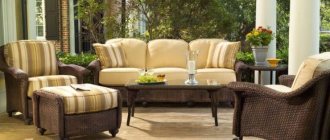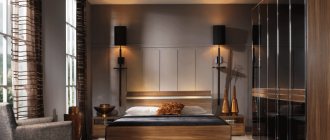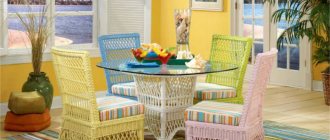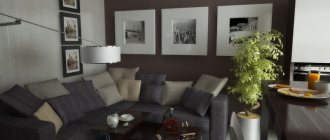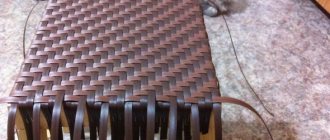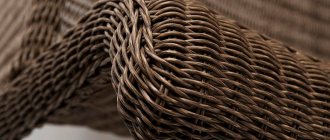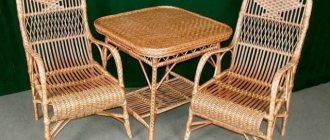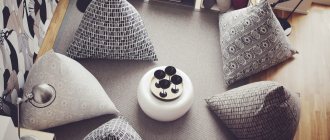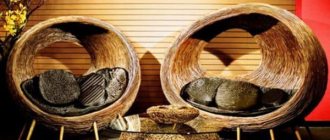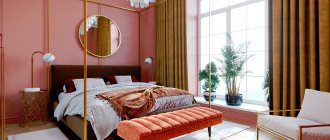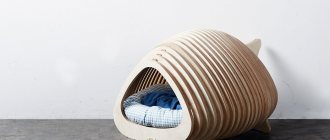SHARE ON SOCIAL NETWORKS
FacebookTwitterOkGoogle+PinterestVk
Wicker rattan furniture is increasingly becoming an integral part of modern interiors. It not only conquered country houses and recreation areas, but also fit perfectly into the eco-style of apartments. Exotic interior items made of rattan bring comfort and coziness into the room, give the warmth of a natural material, and delight with wear resistance. These and other features of rattan furniture, as well as options for its use, will be discussed in this article.
Rattan furniture looks great both in the garden interior and inside the house
Natural rattan: what is it?
The features of any furniture products are determined by the material from which they are made. The production of wicker furniture is no exception. What is rattan? Why did you choose it for the manufacture of wicker furniture?
Natural rattan is a vine from trees of the palm family.
Rattan is an exotic vine of the palm family. It is found in Asia, Australia and Africa. However, among the numerous 330 species of this plant, only a few of them can be used for furniture production, mainly those that grow in Southeast Asia. This choice is due to a number of characteristics that are unique to this material.
The main advantage of rattan is the incredible length of its branches. On average, this value is 200-300 m, but there are also record holders - up to 350 m. This is why it became possible to weave furniture and various products from rattan: the material allows elements to be made without joints or to minimize their number.
Important characteristics of rattan are the same thickness of the stem along the entire length of the vine and the complete absence of knots and shoots. These properties allow you to fully use the length of the vine without waste. The maximum trunk diameter is up to 7 cm; young palm stems are thinner.
The length of rattan branches can reach 350 m, thanks to which furniture can be woven from it almost without joints
One of the advantages of rattan is its strength, which is due to the structure of the tree. The cut of the branch is not hollow inside; it is divided into several layers: bark, porous part and hard core. It is the core that provides the material with excellent resistance to heavy loads. For openwork weaving of furniture, use only it, clearing the stem of all top layers.
This is interesting! Some furniture designs made from natural rattan can withstand a load of 500 kg, and local residents use this raw material in the construction of houses and suspension bridges.
Strength classes and coloring of natural rattan
The smaller the porous part of the vine stem, the stronger the rattan and products made from it. It is customary to divide rattan wood into three strength classes:
Most often, rattan is painted in natural light brown shades or left white.
- class A - the highest, has a premium variety: the rattan trunk is ideal, i.e., without stains, scuffs and other cosmetic defects;
- class B is an intermediate option, products made from it are more affordable in price;
- class C is the lowest limit for rattan furniture, used in products that are not subject to heavy loads.
The strength class affects the cost of rattan furniture. The price of products with exactly the same design may differ by 2-2.5 times if materials of different strength classes were used in production.
Wicker furniture uses raw materials that can be bent at different angles. The stem of a vine in its natural form is not very plastic. To give it the necessary properties, rattan is treated with steam and only after that the production of products begins.
Natural rattan comes in 3 strength classes: A – the highest, B – average and C – low
A rattan trunk ready for production is white, but it can be painted in one of four natural shades:
- honey;
- cognac;
- coffee;
- olive.
If the surface of the raw material is ideal, the natural color is usually left. Very rarely, vines are painted in colors such as red or black. Manufacturers try to preserve and emphasize the beauty and warmth of natural material, but for some design solutions, shade options are possible.
How to do it yourself?
You can buy the chair if you like the idea. But you can also make it yourself if you like to try new things or find the concept itself attractive.
You can make this kind of furniture yourself
You can do it yourself:
- macrame chair – small, round, without armrests, with a wicker bottom;
- a chair with a cover – soft, cozy, also round, on a rattan frame;
- a wicker chair - a cocoon, ideally corresponding to the idea of a rattan chair in general;
It is important to note that all of these chairs are hanging chairs. They can be mounted in the garden on a tree branch or attached to the ceiling at home. This is explained by the fact that it is almost impossible to make a support at home - there is not enough equipment and skill.
Ideal for relaxation
Macrame chair
Weaving a macrame chair from rattan is not difficult, even if you have never weaved from wicker before . You will need:
- rattan rods - for the first time it is better to take plastic, since it is easier for them;
- two wooden hoops, one with a diameter of seventy cm, the second with a diameter of one hundred and ten - you can make them right there from rattan, weaving it with a braid and securing it with strong threads (but first you need to make sure that they will withstand the weight of the structure);
- slings, thick cord, wooden rods with a diameter of three centimeters;
- scissors, tape measure, gloves for work.
It’s not at all difficult to weave such a chair with your own hands
The instructions are not particularly complicated:
- The small hoop that will serve as a seat needs to be braided with rattan rods. In a simple version, rods are attached to it by drilling holes for them. They are fastened in one direction, parallel to each other, at a distance of about half a centimeter, and then thinner rods are woven into them. The first is applied to the first support, passed under the next one, passed over the third, passed under the fourth - and so on. The second rod does the same, but in reverse order.
- When the seat is ready, the surface of both hoops is braided with cord to achieve greater strength. Every twenty turns there is a tightening, in which you need to pull the cord as tightly as possible.
- Braided, both hoops are connected. In one place they are tightly wound with the same cord, in the opposite place two wooden rods are attached - they can be wound or nailed. Their height depends solely on the desired back height.
- Using a cord, the resulting structure is braided around the perimeter using the macrame technique. A simple option is chess. At regular intervals, pieces of cord are attached to the large hoop. Then they connect with each other, forming the first row of nodes. Then the ends are tied further to form diamond-shaped cells.
The main thing is to first secure the cords around the perimeter
Slings are attached to the final chair - two on the back, two in the place where the hoops are attached to each other - and fastened together on one carabiner, which can already be attached to the ceiling. You can choose any colors during the process.
Advice Work with gloves all the time, otherwise you will not only get a new piece of furniture, but also calluses.
Wicker chair
Weaving a full-fledged cocoon with your own hands is a non-trivial task, but not because of the complexity, but because of how much patience it will require. You will need:
- rattan rods - about four hundred pieces, with a diameter of no more than one and a half centimeters;
- wooden hoop - or made from rattan rods woven with a braid;
- strong twine, glue, pruning shears, awl, knife, ruler;
- cord - four millimeters, matching the color of the vine (or additional rods if you want to make the entire chair wicker);
- slings.
It takes a little patience to get this chair.
The manufacturing process takes place sequentially:
- Flatten the hoop so that it becomes oval. Attach the rods to it vertically, so that at the top they are no more than half a centimeter apart from each other, in the middle they bend deeper, moving apart and forming the part of the chair where you are supposed to sit, and at the bottom they come together again.
- Fastening is simple - the rod is bent over the edge of the hoop as far as possible, and then grabbed with a strong cord so that it does not bend back.
- The resulting frame of the chair is braided with thin rods from the bottom up, the simplest weaving, as in the case of a macrame chair. The ends of the rods are attached to the vine and wrapped around it.
- The resulting result is wrapped with a cord around the hoop to hide possible errors, protruding rods, and other decorative defects.
- Slings are attached to the top point of the hoop and to two points below - with a strong knot.
- The slings are tied above the chair, secured with a carabiner, and then attached to the ceiling.
To make sitting on such a chair softer, it is good to put a pillow in it. It turns out to be light, you can hang it anywhere in the house.
Add some pillows
Armchair with cover
The chair with the cover is soft, cozy, not distinguished by the elegance of the pure rattan version, but still beautiful. It will not have to be woven, but sewn. A sewing machine will be useful for this. You will need:
- rattan hoop, two round pieces of fabric several centimeters larger than its size;
- padding polyester for stuffing, slings;
- threads, needles, and other sewing supplies.
In fact, all you need to do is make indents for the slings, sew the round sections together directly on the hoop and stuff the resulting cover with padding polyester. After carefully sew it up, thread the slings through the hoop and hang it from the ceiling.
This chair is made as simply as possible, but you can decorate it by adding a colored pattern, embroidery, applique to the fabric, braiding the visible parts of the hoop with colored threads, and hanging lush tassels along its edges. Any manifestation of imagination is good and will make the result more colorful and interesting.
Advantages and disadvantages of rattan wicker furniture
Rattan furniture is natural, light and aesthetic. The material combines well with leather and textiles, gives designers room for imagination in creating exclusive models and emphasizes the individuality of products, since weaving is done by hand. Other advantages of rattan furniture:
The main advantages of rattan furniture are lightness, strength, moisture resistance and durability.
- natural environmentally friendly material;
- does not contain allergens;
- excellent strength;
- good moisture resistance;
- tolerates temperature changes without problems, so can be used outdoors;
- durability – service life 20-25 years;
- light weight of products, which can be appreciated when rearranging and transporting;
- special smell and texture, plus a bonus in the form of micromassage;
- orthopedic shape of sofas, armchairs and chairs;
- easy care.
The main disadvantage of rattan wicker furniture is the price. Much of the production process is done by hand, so each product is one-of-a-kind and labor-intensive. Another disadvantage is the lack of assembly for the products. On the one hand, this is an advantage, since the furniture arrives to the customer in finished form, but on the other hand, its transportation may require larger vehicles. Natural rattan is “afraid” of the sun: if you constantly keep products in direct sunlight, they will fade and dry out.
The biggest disadvantage of rattan furniture is the high cost of the products.
Helpful advice! If the rattan weave has dried out and small cracks have appeared, lubricate the surface of the furniture with linseed oil. This will protect the product from moisture evaporation.
What types of weaving are there?
When creating a chair, different weaving techniques are used, which allows you to give the finished product a unique and original look.
- The simple type is not difficult; even beginners can handle it. Single rods are woven between the posts, alternating their position.
- The rope is made of at least two rods. They go around each rack from opposite sides.
- Solid thick “Checker”. The working rod (one or more) braids two posts at a time to a certain height. A second rod is woven into the gaps in a checkerboard pattern. The third row is performed similarly to the first, and the fourth - to the second.
Openwork weaving in the form of rhombuses, rosettes, rings, spirals, etc. looks light and airy. It makes it possible to reproduce patterns with open cells.
The braid is used for weaving decorative elements and edges.
The edge of the product is formed using a fold.
Natural and artificial rattan furniture: how to distinguish
Along with furniture made from natural rattan, in stores you can find products made from artificial material - polyrattan. The performance characteristics of both types of furniture are almost the same, but there are differences:
- artificial rattan is completely homogeneous, there are no roughnesses on it;
- if the fibers of the material are geometrically ideal, it is artificial rattan;
- the artificial material has a uniform color throughout the entire product: if you look closely, it is very noticeable;
- Furniture made of polyrattan can be painted in any color; it can also be decoratively processed and textured;
- polymer fibers can have different cross-sections, including ideal flat strips;
- the quality of weaving of artificial material is always higher, and if natural rattan is used in furniture, there will certainly be slight thickenings and minor irregularities;
If the furniture is completely homogeneous, the lines are perfectly smooth and there are no roughnesses, then it is artificial rattan
- furniture made from non-natural material is heavier, because for strength, the weaving is applied to a metal, most often aluminum, frame;
- the price for identical models will be lower for furniture made of polyrattan;
- no matter how hard the manufacturers try, new artificial rattan furniture will fill the room not with the subtle aroma of wood, but with the smell of synthetics; after a week it will disappear, but when heated in the sun it may appear again.
In defense of furniture made of synthetic material, we can say that it is completely unpretentious in maintenance, is more resistant to mechanical stress, and can remain outdoors all year round.
Rattan furniture: photos in the interior and examples of use
Wicker rattan furniture will be appropriate both in a country house and in a city apartment. It will “accept” almost any interior and style; it is important to be able to harmoniously choose accessories and the color of rattan. The range of products is varied: armchairs, chests of drawers, sofas, chairs, coffee tables, cabinets, screens, boxes, beds, lampshades and much more are offered for installation in the bedroom, living room, children's room and even bathroom.
An unusually shaped bed made of natural rattan will become the main decoration of the bedroom
Rattan is a fertile material for designers, which is why photos of rattan furniture have recently become more often used as examples for interior design. Products made from it can take on a variety of shapes while remaining durable and lightweight. Rattan furniture is cozy and comfortable, tactilely pleasant and original, it gives airiness to the interior and smoothes out the geometry, brings light and expands the space.
Rattan chairs: design options and their place in the interior
Rattan chairs are one of the most popular wicker furniture products. They have become popular due to their comfortable orthopedic shape and the variety of designs offered. They are as reliable and comfortable as other types of furniture made from natural wood, but not as bulky and monumental.
Wicker chairs can take a place in the interior of a country house or apartment, become part of a relaxation area in a gazebo, on a terrace or balcony, in a living room or children's room. Rattan chairs come in the following types:
Rattan chairs can be of various shapes and made in different styles
- traditional armchair with armrests;
- rocking chair;
- large oval-shaped Papasan chair.
A traditional chair with armrests will require an addition in the form of a similar coffee table or sofa, a chest of drawers or a lamp, or, in extreme cases, another similar chair. Models with continuous weaving, without openwork lace, and a laconic design are suitable for almost any style.
Related article:
Pine furniture: grace and harmony in interior design
Advantages and disadvantages. Varieties of pine products. Scope of use. A combination of style and practicality. Recommendations for making furniture with your own hands.
A rocking chair can “live” autonomously in the interior and not be tied to the decor of one room, since its light weight allows you to easily move it from place to place.
The large oval Papasan chair - a stable original design with a single “leg” - will appeal to everyone. It is worth choosing weaving to match the main furniture and complementing the chair with a mattress or pillows in colors that match the style. The chair itself claims to become a concentration of comfort in a house or apartment.
Rattan chair is the most popular type of furniture made from this material.
Options for using a rattan sofa in the interior
You can safely place a wicker sofa where guests often visit or children play, because furniture is primarily installed not for beauty, but for use. The design of rattan sofas is durable, the frame is reliable, and comfort is guaranteed. The product can withstand heavy loads, including several guests at the same time.
Sofas are most often included in a set of rattan furniture in an ensemble with armchairs and a coffee table. Sofas with different weaves are selected for different interiors. The Victorian style will suit furniture in light shades, for classics and minimalism - with solid weaving, and Art Deco will require a strict, no-frills style and dark tones.
Wicker sofas are placed in offices and living rooms, reception areas in the office, in the country - under the canopy of a gazebo or on the veranda. Structurally, rattan sofas can be straight or angular, with high or low legs, with or without additional storage compartments.
A rattan sofa will look chic in a living room, office or on the veranda
Safe wicker furniture: rattan for children's rooms
The arrangement of a children's room always has special requirements for environmental friendliness, safety and the organization of maximum free space for games. The main advantage of rattan furniture is its safety and environmental friendliness. Weaving does not provide sharp corners in the designs, therefore, parents will not be afraid that the child will injure himself.
In the nursery, you can place the sets as a single ensemble, select a set of rattan furniture from different but color-matching elements, or complement the finished interior with separate products. Wicker furniture is very light, and if children decide to use it for games, then you don’t have to worry about injuries if the constructed structure turns out to be not too strong.
Chests of drawers are perfect for storing things: a child can easily handle the lightweight drawers and find everything he needs on his own. The wicker structure will ensure that clothes always remain fresh thanks to good air exchange. For the same purpose, you can use separate baskets installed on open shelves. They are also good for storing toys.
Children and teenagers will love the rattan hanging chair
Bookcases and shelves for various small items and books are very practical. They can be combined in height, selected in width and easily rearranged if necessary. Rattan furniture can withstand heavy loads, so over time the shelves will not bend under the weight of the load.
Helpful advice! Although rattan furniture is very durable, it is not recommended to stand on it or jump on it. This may cause the product to break.
If space allows, a good solution would be to install a rocking chair, an oval wicker Mamasan sofa or a large Papasan chair in the children's room. Such furniture elements will appeal to both children and teenagers. Supplement them with decorative pillows or covers that match the overall style - and get an exclusive interior for the nursery.
Is it appropriate to use rattan furniture for a garden?
Interior items made from natural rattan can be used for cottages, gazebos and terraces. Country furniture made of rattan is resistant to temperature changes, can withstand rain, it is light and easy to care for, therefore it meets all the basic criteria characteristic of this type of furniture. However, it does not tolerate drying out well, so it is better not to install it under the sun.
Rattan furniture - fits especially well into landscape interiors
When arranging terraces and gazebos, sets of rattan wicker furniture are actively used. Photos of the organization of such interiors are very popular on the Internet. The most commonly used models are sofas of various shapes, armchairs, tables and chairs. Also in a country house they install hanging sofas in the form of a swing.
When choosing interior items for your dacha, you need to focus on the overall style in the house. If the terrace is large, then you can put furniture of any size. For small areas, designers recommend installing wicker products in light colors and modest sizes.
Helpful advice! If rattan furniture gets wet from heavy rain, let it dry completely and do not use it for at least a day.
You can place a stylish rattan coffee table on the terrace or gazebo
Color combinations
Since we're talking about wicker furniture in a modern interior, I'll show you a couple more illustrations.
Natural colors, loved by this style, go well with the color of rattan (rattan, as it is often called), bamboo, wicker - those materials that are used to create this type of furniture. White walls and oak floors are an excellent backdrop for it. Take note if you want an unusual and light interior.
Another interesting application option in a modern interior is in the photo above. Here, a light straw-colored wicker sofa fits perfectly into the interior with a base combination of rich terracotta chocolate (walls) and orange (accessories).
The final picture is thick and juicy, but not heavy – largely due to the large, laconicly designed window. In general, in modern interiors experiments with wicker furniture are very productive.
Painted wicker furniture
One such experiment is painting in different colors, as in the photo above. The result is quite interesting - the structure has been preserved, and the rich colors in which the straw is painted have acquired a characteristic muted shade.
Pretty good, in my opinion, although it destroys the main idea - the naturalness of the material and color.
Synthetic options
But what experiments seem absolutely unacceptable to me are synthetic wicker furniture. The photo above is not the worst example, the worst ones look so ugly that I don’t want to show them.
Synthetic wicker furniture looks slimy and cold - completely contrary to the idea of naturalness. No matter how great the temptation to purchase synthetic options is, do not give in to it, the result will disappoint you.
More about color combinations
Let's talk a little more about the colors that wicker furniture goes with. This depends, of course, on its color - for example, golden brown, as in the photo on the left, goes well with white, milky white, golden yellow and red.
Golden yellow wicker furniture, like the photo below left, goes well with pastel colors, especially blue. Wicker furniture in dark brown and chocolate colors, as in the photo below on the right, looks amazing with bright green.
Natural partners of wicker furniture are all natural colors - sand, milky white, cream, café au lait, caramel, khaki, gray stone, etc.
To prevent the result from being too boring, you can add accessories in bright colors - for example, fuchsia, as in the photo above, or turquoise, pistachio, grass green, orange, coral, bright blue.
Other options for placing rattan furniture in an apartment
Rattan furniture can be installed in different parts of the apartment: in the bedroom, dining room, bathroom, hallway, kitchen and balcony. Beds, wardrobes, chests of drawers, bedside tables, poufs are placed in the bedroom as a set or selectively by detail, matching them to the main furniture by color and style.
In the kitchen, bathroom and hallway, the use of rattan furniture is possible due to its moisture resistance. Storage systems are mainly applicable here: cabinets, baskets, shelves. In the kitchen or dining room, the dining area is complemented with rattan chairs because of their convenience, lightness and wonderful combination with solid wooden tables. The design of the chairs gives a wide choice for organizing a different interior; this is facilitated by variations in the height and curvature of the back, the presence of armrests, weaving techniques, etc.
In addition, rattan can be used as decoration. It is used to make rugs, wall panels, openwork screens, mirror frames and even furniture for pets. This material brings positive energy into the home and promotes comfort, which is why it is becoming more and more popular every year.
The headboard of the bed, made of rattan, looks impressive, beautiful and unusual
Decor
To update the existing interior and create a comfortable environment in a furnished room, it is enough to replace some decorative elements. Wicker products - baskets, trays, bedside tables, tables or chairs - are perfect for these purposes.
A coffee table with a glass top is universally integrated into the interior of any style. In combination with transparent surfaces, rattan in the interior acquires amazing properties. You get the feeling that this element of decor has always been present here, the atmosphere becomes so cozy. And adding pillows and blankets in the appropriate style to the sofa standing next to it will add some comfort.
Basic rules for caring for rattan products
Rattan wicker furniture is easy to care for, but it still needs it. In order for products to retain their appearance for a long time, several rules should be followed:
- when using wicker furniture for a summer house, do not leave it in the open air for the winter; it is more advisable to bring it into the house until spring;
- try to avoid chips and scratches on the protective varnish layer;
- Do not place rattan furniture near an open fire or near a radiator: it will quickly dry out and become fragile;
- do not place hot objects on the surface and avoid exposure to any chemicals;
- if the furniture gets very wet, dry it well and ventilate it so that mold does not form in the weaving cells;
To prevent rattan furniture from losing its appearance, it must be wiped with a damp soft cloth.
- to remove dust from furniture, you can use a piece of cloth or a vacuum cleaner; for heavy dirt, use a damp sponge soaked in a soap solution;
- furniture must be protected from drying out, so you should regularly wipe it with a damp, but not wet, sponge;
- Once a year, rattan products undergo global cleaning with washing with detergent and subsequent thorough drying.
